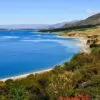From the world, Issue 11/2024
Meanders of rivers
Rivers are a fascinating part of our planet’s geography. They attract researchers and tourists with their uniqueness, and it doesn’t matter whether it’s the mighty Mississippi or our native Vistula. As a result of erosion and sedimentation processes, they form meanders, or picturesque meanders and loops, especially in lowland areas.
How are the meanders formed?
Water flowing at a higher speed is pushed outward from the river by centrifugal force, leading to erosion at the bend. The outer bank becomes steep due to undercutting by the current, and the inner bank softens, as sediment deposition occurs on it in the form of a meander bank (meadow, skimming). Continuous erosion on the outer banks and deposition on the inner banks leads to the formation of loops on rivers. Meanders move as the river progresses toward the mouth. This means that over the years they can increase their curvature and widen the valley. Sometimes they are also cut off from the main course, for example, due to a temporary rise in the water level and the washing out of a new channel. Then the former meander becomes an old river bed.
Winding cases: where the waters flow in meanders
The Mississippi River is one of the most important and longest rivers in the United States. It flows through 10 states and is about 3778 kilometers long. Its sources are in the northern part of the state of the same name, and its mouth is in the Gulf of Mexico. The Mississippi is known for its scenic meanders. Its course is variable, and the speed of the water and deposition of material changes the landscape of the valley. The river has evolved considerably over the past 250 years. The main trough was moving, with new troughs being created after floods. The Mississippi’s meanders form distinctive oxbow lakes. These are meanders that are cut off from the main course of the river, crescent-shaped bodies of water. Despite man’s actions, traces of the past are still visible. Roads and fields often follow the contours of former troughs.
Another river known for its meanders is the Meander (Menderes), which is located in Turkey and to which this geographical form owes its name. Menderes’ run was so uniquely winding that it became synonymous with something complicated and intricate.
Another winding river, the Jordan, flows through Israel, Jordan and Palestine, and its meandering course is a distinctive feature of the region’s landscape. It forms picturesque loops that attract the attention of researchers and pilgrims. It is a symbol of transience and rebirth.
The Vistula River flows, the Nida River flows… with bends and loops
The Nida River is one of the most picturesque rivers in Poland. Its meanders, history and ecosystem are an important topic of geographic research. The area of the extended Nida valley, known as the central delta, was once attractive because of its morphological structure. Cartographic and geological studies have shown significant changes in the estuary of the Nida River and the Vistula riverbed over the past 250 years. They were created both naturally and as a result of human activity. Areas associated with the main river channel often form wetlands that are regularly inundated by floods. This is an excellent environment for flora and fauna to thrive.
The Vistula, Poland’s longest river, is a living artery of the country that has shaped its landscape, culture and history for centuries. The meanders of the Vistula are a testament to the river’s dynamic past, which dates back some 30 million years. In the mountains, the Vistula riverbed took its current shape much earlier, adapting to the geological structure. In the lowlands, its evolution depended on the history of successive glaciations, and especially on changes during the interglacial period, when the Vistula left its previous east-west oriented valley and established its current direction – north.
The importance of meanders in nature conservation
Natural meandering rivers play an important role in storing water and slowing its flow. Changing the course of the river, straightening and strengthening the channels lead to an acceleration of the current, which increases the risk of flooding in the valleys. As a result of the elimination of meanders and changes in riverbed morphology, rivers are losing their ability to clean themselves in many sections.
River meanders perform important functions in the environment:
- A habitat for wildlife: meanders create a variety of habitats, important for aquatic and aquatic-terrestrial organisms;
- Material deposition: the winding course of the river promotes the deposition of sand, gravel and organic matter along the course of the river;
- Regulation of sediment transport: affect sediment transport in rivers;
- Regulate the velocity of flows: slow down the current, have a flood control effect.
Ill-considered regulation of rivers, dictated by attempts to provide flood protection or control flow, often produces unexpected results. It should be performed only where it is necessary and properly justified, in accordance with the requirements of the Floods Directive and the Water Framework Directive. There is a lot of talk these days about the need for river restoration. The latest EU Biodiversity Strategy 2030 calls for, among other things. Protection of freshwater ecosystems, with which renaturalization is associated. Ensuring free flow will not only restore natural floodplains, but also free fish migration and flow, and thus have a positive impact on water quality.

 Polski
Polski







